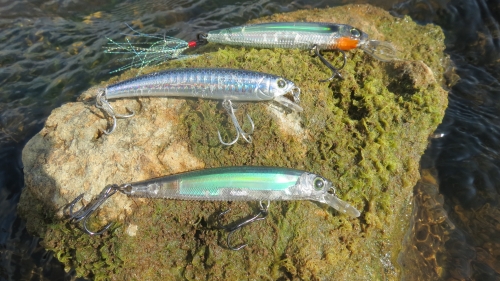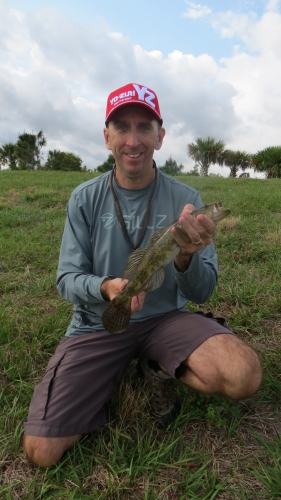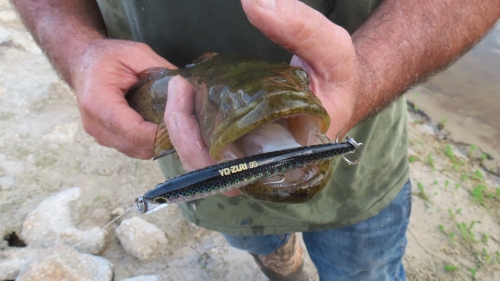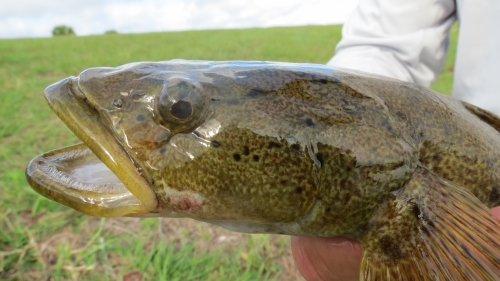BLOG
In Search of a Sleeper
By: Steve Wayne

The retention pond was teaming with life! I stared down into the clear water and watched as a giant tilapia and a small 1 lb. bass swam lazily by my vantage point. A school of finger mullet darted nervously past the wary bass which indicated that the retention pond was in some way connected to the nearby Indian River Lagoon in Brevard County. I was targeting largemouth bass but welcomed any of the various species of brackish water fish such as snook, tarpon or redfish that might inhabit the pond. My bait of choice for this adventure was a Yo-Zuri 3D Jerkbait, a lure that would likely catch any type of predator fish that swam in either freshwater or salt. I surveyed the pond and spotted my intended target, a large grass bed that formed a point at the mouth of a nearby ditch that emptied into the retention pond. I casted the Yo-Zuri 3D Jerkbit well past the grassy point and slowly retrieved the bait along with the direction of a slight current coming out of the ditch. As the bait neared the point I watched as an attacking fish swirled at my bait! I instantly felt a hit and then set the hook on a decent size fish. The fish surged to the left easily taking drag. After a short battle I stared down into the clear water trying to decipher what was on the end of my line. The olive brown fish looked like a cross between snakehead and some type of goby. As I dragged the fish up the muddy bank, I realized that I had caught a rare catch, a bigmouth sleeper!
Bigmouth sleepers, Gobiomorus dormitor are a torpedo shaped fish with dull coloration that can vary from a light or dark brown to olive. They have a short broad head with a blunt snout. This species of fish has a large cavernous mouth-hence the name “Bigmouth” and can often swallow surprisingly large prey. The bigmouth sleeper has 2 dorsal fins as well as a broad and round caudal fin. According Florida Fish and Wildlife Conservation Commission’s (FWC) Research Administrator, Dr. Richard Paperno, bigmouth sleepers vary in length and can grow to almost 3 feet. They are found in rivers and bays on the Atlantic coast normally south of Melbourne. They inhabit the Sebastian River, St. Lucie River, Loxahatchee River as well as other brackish water canals and creeks in central and south Florida. Dr. Paperno advises that bigmouth sleepers are not abundant north of the Sebastian River, however the FWC has occasionally collected several samplings from as far north as the Jacksonville area. “Bigmouth sleepers do occur elsewhere in Florida, just not in very great numbers. They are in a group of fishes collectively referred to as tropical peripherals. Their center of abundance occurs in more tropical areas south of Florida, but they have managed to get a foothold in Florida, existing on the periphery of their normal habitat range” advises FWC’s Dr. Paperno. In addition to Florida, bigmouth sleepers are commonly found in the Mississippi River and along the rivers and bays of coastal Texas.
Bigmouth Sleepers spend most of their time in freshwater and are believed to travel to the brackish estuaries or marine waters to spawn. After spawning the juveniles move back into the freshwater tributaries. In some places where they have been trapped in freshwater due to development, they have been able to adapt and complete their entire life cycle in freshwater. Bigmouth sleepers are predator fish and feed on smaller fish, shrimp and crustaceans. The bigmouth sleeper lies on the bottom with slow moving currents to blend in to the bottom with its sluggish behavior and dull coloration. Brevard County angler, Gil Tompkins regularly catches big mouth sleepers while fishing brackish water spillways along the space coast and treasure coast. “I’m usually targeting bass or snook in front of the spillways but frequently catch bigmouth sleepers” explain Tompkins. “They are fun to catch!”

Bigmouth Sleepers will readily attack minnow type jerkbaits, lipless crankbaits, small swimbaits and flukes fished in the middle of the water column. Keep your color selection simple by matching the forage of the area that you are fishing. Basic chrome, silver and white are often good choices as they will imitate small finger mullet or minnows. Although bigmouth sleepers have a large mouth keeping your bait choice to under 4” will increase the chance of a good hookup. Yo-Zuri’s 3D line of jerkbaits are excellent producers and come in a 3 ½” size that easily imitate a finger mullet. Cast your lure in and around the mouth of spillways and areas with current making sure to retrieve your bait in the direction of the current in a natural manner. Slow and steady is the key as bigmouth sleepers are ambush predators that won’t swim very far to chase down a meal. Don’t be afraid to cast up tight to the bank as bigmouth sleepers will get very shallow in anticipation for an unsuspecting baitfish to drift by in the current. “I’ve caught fish right up against the rocks” exclaims Tompkins.
Live baits such as shiners, finger mullet, mud minnows and shrimp are excellent choices to fool bigmouth sleepers. As with lures, keeping the size of your baits to under 4 inches will increase the chance for a successful hookup. Freelining live baits as well as using a float are affective techniques. Bigmouth sleepers generally run in the 1 to 2 lb. range however, a 20 to 30 lb. Yo-Zuri Top Knot fluorocarbon leader is recommended in case you encounter a larger brackish water species. “I always use a leader because you never know when you might hook into a snook, tarpon or a big gar!” explains Tompkins. “I’ve caught bass, snook, redfish, tarpon, gar, speckled perch and mangrove snapper all in the same areas with the bigmouth sleeper” boasts Tompkins.
Bigmouth sleepers can be targeted year-round with the best months occurring during the warmer periods of spring summer and fall. Focus on smaller brackish water spillways in central and south Florida with minimal but steady current. Avoid large spillways with fast and rolling current as bigmouth sleepers prefer quiet areas to lay on the bottom while awaiting an easy meal to drift by in the mild current. To scout out a prospective spillway, make sure that spillway flows from freshwater into salt or brackish water. The presence of freshwater species of fish at the mouth of the spillway such as bass, bluegill or tilapia are a good indication that bigmouth sleepers may be present!
The FWC designates the bigmouth sleeper as a “restricted species of marine life” along with other species of ornamental tropical fish. Many fishermen targeting bigmouth sleepers value them as a rare and unique fish and immediately release any fish back into the water. There is no size limit with a daily bag limit of no more than 5 of any one “restricted species of marine life”, which includes the bigmouth sleeper. Any fish harvested (kept) must be maintained alive as part of FWC’s “restricted species of marine life” requirement. The FWC does not maintain a state record for the bigmouth sleeper, however the International Game Fish Association has documented a world record of 4 lbs. 6 oz. caught in 2001 in Costa Rica.
Bucket list anglers may want to add the bigmouth sleeper to their list of unique Florida catches such as with the Suwanee bass, clown knifefish, peacock bass and the bullseye snakehead. Due to the bigmouth sleeper’s specific habitat and range in Florida, they are indeed an uncommon species and the envy of any angler desiring on a rare catch!

Side Bar
Targeting Bigmouth Sleepers:
• Focus on warm months when bigmouth sleepers are more active.
• Locate brackish water spillways in central and south Florida.
• Favor small spillways with mild current.
• Avoid large spillways with fast or rolling current.
• Artificial lures used should be less than 4 inches in length to ensure a solid hookset.
• Try jerkbaits, lipless crankbaits, small swimbaits or flukes fished in the middle of the water column.
• Live bait can be excellent for bigmouth sleepers. Try finger mullet or shiners freelined or fished under a cork.
• Always use a 20 to 30 lb. fluorocarbon leader in case of snook or other toothy fish.
• Once a bigmouth sleeper is landed, there is the likelihood that there are others present. Keep casting!
• Practice catch, photograph and release!

